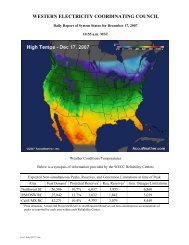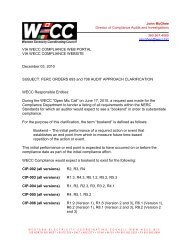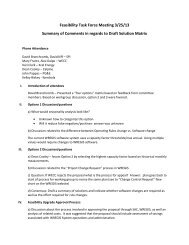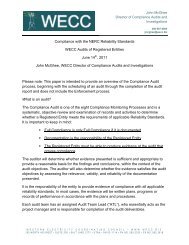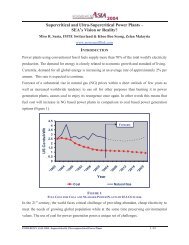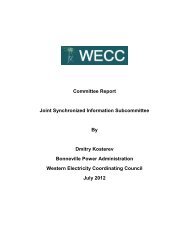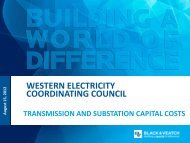Path Rating Catalog 2013 - Western Electricity Coordinating Council
Path Rating Catalog 2013 - Western Electricity Coordinating Council
Path Rating Catalog 2013 - Western Electricity Coordinating Council
You also want an ePaper? Increase the reach of your titles
YUMPU automatically turns print PDFs into web optimized ePapers that Google loves.
66. COI<br />
Revised January <strong>2013</strong><br />
Accepted <strong>Rating</strong><br />
Existing <strong>Rating</strong><br />
Other<br />
Location: Between Oregon and northern California<br />
Definition: Line Owner Metered End<br />
Transfer Limit:<br />
Critical<br />
Disturbance<br />
that limits the<br />
transfer<br />
capability:<br />
When:<br />
System<br />
Conditions:<br />
Study Criteria:<br />
Malin to Round Mt. 500 kV<br />
Joint<br />
Malin<br />
(2 lines) (Pacific AC Intertie)<br />
(north end)<br />
Captain Jack-Olinda 500 kV line (COTP) Joint Captain Jack<br />
(north end)<br />
4800 MW North to South<br />
3675 MW South to North<br />
With north to south transfers, the critical outage is the loss of two Palo Verde<br />
units or the DC Bipole outage. The critical outage for the California portion<br />
of the COI when transfers are north to south is the south of Table Mt. 500 kV<br />
outage (Table Mt. To Tesla and Table Mt. To Vaca-Dixon) that could<br />
potentially cause thermal overloads on the underlying system.<br />
With south to north transfers, the critical outages are (1) single line outage of<br />
the Captain Jack-Meridian 500 kV line or the PDCI, (2) a double line outage<br />
of the Malin-Round Mt. 500 kV lines, and (3) a double line outage of the<br />
Ashe-Marion and Buckley-Marion 500 kV lines (this latter outage is limiting<br />
with high west-side loads in Oregon). Most of these critical outages were<br />
limiting due to voltage stability margin.<br />
The 4800 MW north to south rating was established in 1986 through the<br />
WECC Annual Progress Report Procedure. Update reports have been<br />
submitted each year since 1992.<br />
The 3675 MW south to north limit was established in November 1992.<br />
Six cases were studied (Heavy Summer; Heavy Spring; Light Winter; PG&E<br />
importing; PG&E exporting; BPA spring).<br />
• The PDCI is 3100 MW (n-s) in the N-S cases, 2000 MW (n-s) in the<br />
PG&E import case and 2000 MW (s-n) in the S-N cases.<br />
• Northern California hydro is at 60% of generating capacity in the<br />
BPA spring case and 90% in other cases.<br />
• Cases were developed showing both 1 and 2 units on line at Diablo<br />
for the Spring and Summer. The light winter case had 2 units on line<br />
as does the PG&E import case. The PG&E export case has 1 Diablo<br />
unit on line.<br />
All facilities loaded within normal ratings under normal system conditions.<br />
All facilities loaded within emergency ratings under outage conditions.<br />
The system meets the WECC voltage stability criteria recommended by TSS.<br />
Fully meets WECC reliability criteria in effect at time rating was established.<br />
The study’s results meet the reliability criteria of all utilities in the Northwest<br />
and northern California.<br />
PART VI Item 1-174



